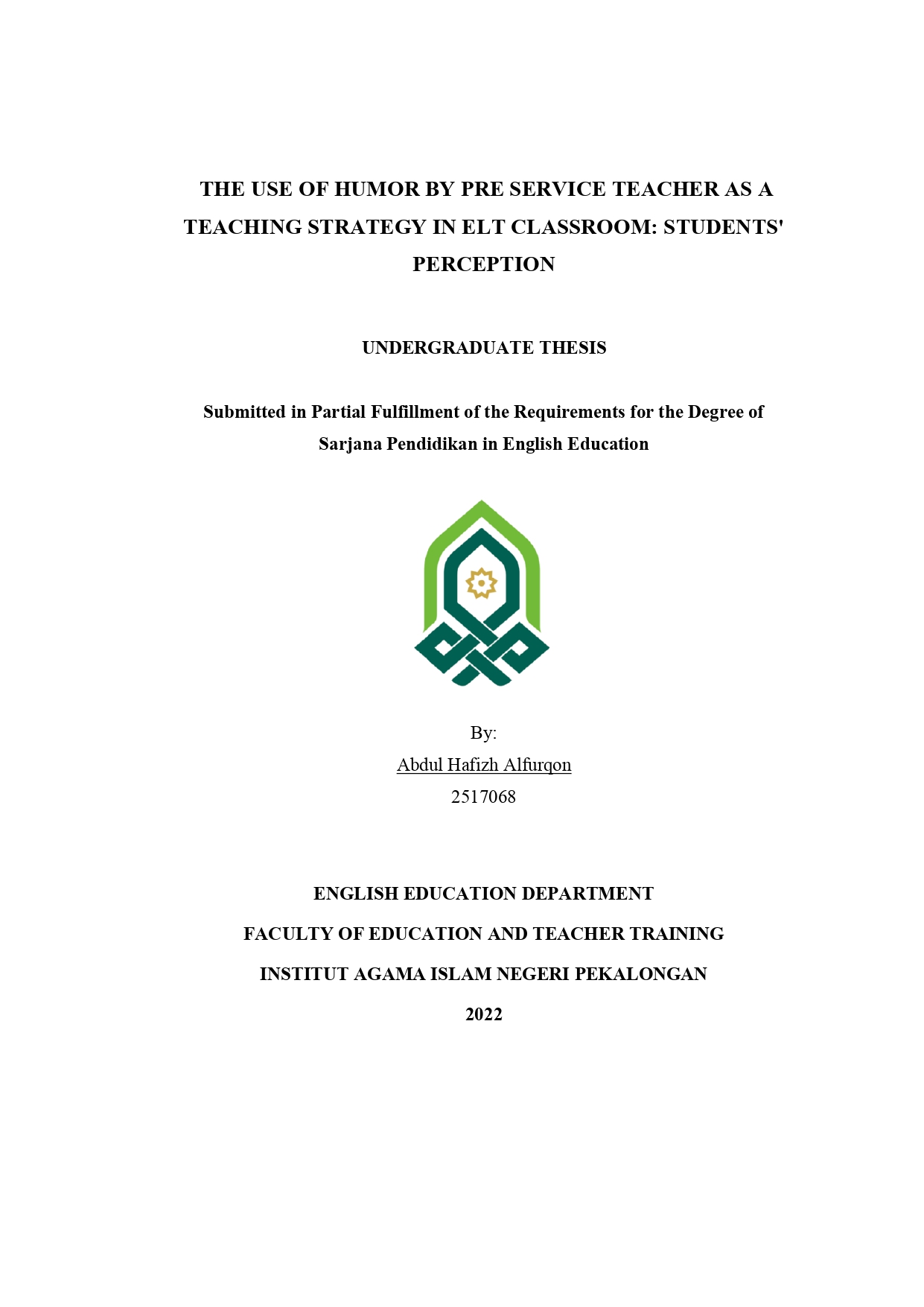
SKRIPSI TADRIS BAHASA INGGRIS
The Use of Humor by Pre-Service Teacher as a Teaching Strategy in ELT Classroom: Students' Perception
Humor as a teaching strategy is one of the alternative strategies used in ELT classroom, passed by many studies related to humor. This study aims to find out what types of humor are used by Pre-service teacher during PPL by focusing on Wanzer's theory; besides, it explores students' perceptions of humor as a form of strategy in EL classroom. This research is qualitative research with a narrative design. There are six participants in this study: one pre-service teacher and five students of class XI Mipa 1 SMAN 1 Bojong. The findings in this study explain that there are two outline forms, namely appropriate & inappropriate humor used by apprentice teachers; appropriate consists of 4 classifications, namely topic related humor, unrelated humor, unintentional humor, and self disparage, and singular inappropriate humor with humor that should not be used by teachers in the classroom, besides that the next finding is that there are four forms of perception related to humor, namely benefits, risks, duration related to humor, and how humor delivered.
Keywords : Humor as teaching strategy, ELT classroom, Perception.
REFERENCE
Al-Duleimi, A. D. D., & Aziz, R. N. (2016). Humour as EFL Learning-Teaching Strategy. Journal of Education and Practice, 7(10), 105–115. Retrieved from https://files.eric.ed.gov/fulltext/EJ1099483.pdf
Alkhattab, M.A. (2012). Humor as a Teaching Strategy: The Effect on Students' Educational Retention and Attention in a Nursing Baccalaureate Classroom. Retrieved from https://scholar.valpo.edu/cgi/viewcontent.cgi?referer=&httpsredir=1&article=1000&context=msn_theses
Bell, Nancy & Pomerantz, Anne (2016). Humor in the Classroom. A Guide for Language Teachers and Educational Researchers. New York: Routledge.
Bergen, Doris (1992). Teaching Strategies: Using Humor to Facilitate Learning. Childhood Education, 69(2), 105–106. https://doi:10.1080/00094056.1992.10520903
Bryant, Jennings; Comisky, Paul; Zillmann, Dolf (1979). Teachers’ humor in the college classroom. Communication Education, 28(2), 110–118. https://doi.org/10.1080/03634527909378339
Busler, J., Kirk, C. Keeley, & Buskist, W. 2017. What constitutes poor teaching? A preliminary inquiry into the misbehaviors of not-so-good instructors: Teaching of Psychology, 44(4), 330-344. https://doi.org/10.1177/0098628317727907
Cambridge Dictionaries. (2021). https://dictionary.cambridge.org/dictionary/english/perception
Chabeli M. (2008). Humor: a pedagogical tool to promote learning. Curationis, 31(3), 51–59. https://doi.org/10.4102/curationis.v31i3.1039
Connelly, F. M., & Clandinin, D. J. (1990). Stories of Experience and Narrative Inquiry. Educational Researcher, 19(5), 2–14. https://doi.org/10.3102/0013189X019005002
Creswell, J. W. (2014). Research Design: Qualitative, Quantitative, and Mixed Methods Approaches (4th ed.). USA: SAGE Publications, Inc.
Englert L. M. (2010). Learning with laughter: using humor in the nursing classroom. Nursing education perspectives, 31(1), 48–49. Retrieved from Learning With Laughter:Using Humor in the Nursing Classroom : Nursing Education Perspectives (lww.com)
Frymier, A. B., Wanzer, M. B., & Wojtaszczyk, A. M. (2008). Assessing students' perceptions of inappropriate and appropriate teacher humor. Communication Education, 57(2), 266–288. https://doi.org/10.1080/03634520701687183
Garner, R. L. (2006). Humor in Pedagogy: How Ha-Ha Can Lead to Aha! College Teaching, 54(1), 177–180. http://www.jstor.org/stable/27559255
Hsieh, C. J., Hsiao, Y. L., Liu, S. J., & Chang, C. (2005). Positive psychological measure: constructing and evaluating the reliability and validity of a Chinese Humor Scale applicable to professional nursing. The journal of nursing research : JNR, 13(3), 206–215. https://doi.org/10.1097/01.jnr.0000387542.91254.42
Jennings Bryant PhD & Dolf Zillmann PhD (1989) Chapter 2: Using Humor to Promote Learning in the Classroom, Journal of Children in Contemporary Society, 20:1-2, 49-78, https://doi.org/10.1300/J274v20n01_05.
Martin, R. A. 2007. The psychology of humor: An integrative approach. San Diego, CA: Elsevier.
Martin, R. A., & Dobbin, J. P. (1988). Sense of humor, hassles, and immunoglobulin A: evidence for a stress-moderating effect of humor. International journal of psychiatry in medicine, 18(2), 93–105. https://doi.org/10.2190/724b-3v06-qc5n-6587
Martin, R. A., Puhlik-Doris, P., Larsen, G., Gray, J., & Weir, K. (2003). Individual differences in uses of humor and their relation to psychological well-being: Development of the Humor Styles Questionnaire. Journal of Research in Personality, 37(1), 48–75. https://doi.org/10.1016/S0092-6566(02)00534-2
McDonald, S.M. (2011). Perception : A concept analysis. Austin State University, Texas.
Minchew, S. S. 2001. Teaching English with Humor and Fun: American Secondary Education, 30: 1, 58-70.
Neumann, D. L., Hood, M., & Neumann, M. M. (2009). Statistics? You Must be Joking: The Application and Evaluation of Humor when Teaching Statistics. In Journal of Statistics Education (Vol. 17, Issue 2). www.amstat.org/publications/jse/v17n2/neumann.html
Nguyen, S. 2009. Class Clowns – Laughing While Learning. [Online] Available: http://yahoo.com/class-clown-laughing-while-learning-4538861.html.
Ou, Q. (2017). A Brief Introduction to Perception. Studies in Literature and Language, 15, 18-28. Retrieved from http://www.cscanada.net/index.php/sll/article/view/10055
Ketersediaan
| 23SK2325010.00 | SK TI 23.010 ABD t | My Library (Lantai 3. Local Content) | Tersedia |
Informasi Detail
- Judul Seri
-
-
- No. Panggil
-
SK TI 23.010 ABD t
- Penerbit
- Pekalongan : Jurusan S-1 Tadris Bahasa Inggris FTIK UIN K.H. Abdurrahman Wahid Pekalongan., 2022
- Deskripsi Fisik
-
xi, 43 hlm., 30 cm; Bibliografi: 44-46
- Bahasa
-
Inggris
- ISBN/ISSN
-
-
- Klasifikasi
-
371. 3
- Tipe Isi
-
-
- Tipe Media
-
-
- Tipe Pembawa
-
-
- Edisi
-
-
- Subjek
- Info Detail Spesifik
-
-
- Pernyataan Tanggungjawab
-
Abdul Hafizh Alfurqon (2517068)
Versi lain/terkait
Tidak tersedia versi lain
Lampiran Berkas
Komentar
Anda harus login sebelum memberikan komentar
 Karya Umum
Karya Umum  Filsafat
Filsafat  Agama
Agama  Ilmu-ilmu Sosial
Ilmu-ilmu Sosial  Bahasa
Bahasa  Ilmu-ilmu Murni
Ilmu-ilmu Murni  Ilmu-ilmu Terapan
Ilmu-ilmu Terapan  Kesenian, Hiburan, dan Olahraga
Kesenian, Hiburan, dan Olahraga  Kesusastraan
Kesusastraan  Geografi dan Sejarah
Geografi dan Sejarah